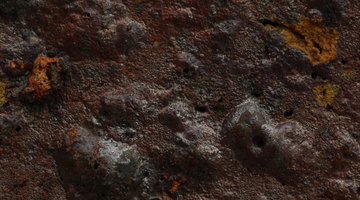Reasons for Paint Blisters on Concrete
Concrete is advantageous and very durable for a wide variety of applications, but the material is an unattractive, dingy gray color. Paint greatly improves the appearance, but it may develop unsightly blisters or cracks.

Reasons for paint blisters on concrete depend on the installation process, type of paint used or a chemical reaction from the concrete.
Moisture
Moisture is the enemy of any paint job, and this problem is exacerbated by concrete's particular water-retaining properties. Concrete is porous; moisture of any kind -- seeping water, flowing water or water vapor from humid air -- pass through microscopic pores in concrete. When installed, new concrete exudes great quantities of water vapor as it hardens and cures. Paint that has been applied atop new concrete hinders water evaporation during the curing process. Additionally, a high groundwater table or a leak from, for example, an underground pipe, will saturate the concrete and cause the pores to fill with water. Water makes its way to the concrete surface, forming small blisters of moisture below the paint surface. Removing the source of moisture may alleviate or remove the formation of paint blisters on concrete.
Inferior Products
Due to the porous properties of concrete and its use in exterior or below-grade applications where water is usually present, general house paint or other types of all-purpose primers and paints are unsuitable for concrete. These paints provide a solid, impermeable barrier over the concrete, preventing water vapor release and forming blisters as the paint separates from the concrete. Manufacturers have developed stains and paints specially formulated for concrete applications to prevent this. When applied, these products form very tiny, microscopic holes over the concrete surface, enabling the concrete to exude water vapor without blistering or peeling.
Improper Preparation
All paint and stain applications require a properly prepared surface that will enable the paint to "grab" the concrete and stick to it. A smooth or new surface will not hold paint unless the surface has been etched or lightly striated. New paint applied to old paint layers may not adhere properly, and the paint may blister or flake off.
Chemical Reaction
Efflorescence is the dusty or crystalline white byproduct of salts and water that exude from concrete pores, the result of a chemical reaction in concrete. Efflorescence is normal for new Portland cement applications, but the presence of efflorescence in older concrete usually belies an underlying moisture problem. Paint applied to concrete experiencing efflorescence will bubble and blister. When broken, small pockets of white powder may ooze from the blisters.
The Drip Cap
- Concrete is advantageous and very durable for a wide variety of applications, but the material is an unattractive, dingy gray color.
- Concrete is porous; moisture of any kind -- seeping water, flowing water or water vapor from humid air -- pass through microscopic pores in concrete.
- All paint and stain applications require a properly prepared surface that will enable the paint to "grab" the concrete and stick to it.
- New paint applied to old paint layers may not adhere properly, and the paint may blister or flake off.
- When broken, small pockets of white powder may ooze from the blisters.
References
Resources
- Home Maintenance For Dummies; James Carey and Morris Carey
- University of North Texas: Concrete and Masonry: Repairs and Utilities
- Exterior Style; Inspiring Color Ideas And Expert Painting Advice; Benjamin Moore & Co.
- New Complete Do-It-Yourself Manual; Reader's Digest; 1991
Writer Bio
Rebecca Mecomber, a former radio broadcaster, has been a professional blogger and writer since 2006. Her articles and interviews have appeared in "The Wall Street Journal," Salon.com and several other publications, covering topics such as Federal Trade Commission policy and media regulations, blogging, home improvement and New York travel.
Photo Credits
- Photos.com/Photos.com/Getty Images
- Photos.com/Photos.com/Getty Images
More Articles



